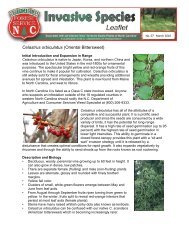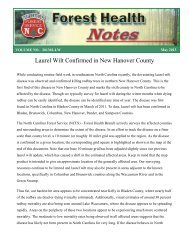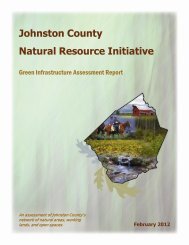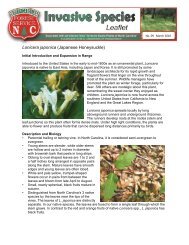Northampton County Honors the Morey's - NC Forest Service
Northampton County Honors the Morey's - NC Forest Service
Northampton County Honors the Morey's - NC Forest Service
- No tags were found...
Create successful ePaper yourself
Turn your PDF publications into a flip-book with our unique Google optimized e-Paper software.
25Ozone Affects <strong>Forest</strong> WatershedsScientists find ozone causes forests to use more water, reducing availability in <strong>the</strong> Sou<strong>the</strong>astRALEIGH, <strong>NC</strong>, October 18, 2012 – U.S. <strong>Forest</strong> <strong>Service</strong> and Oak Ridge National Laboratory (ORNL) scientistshave found that rising levels of ozone, a greenhouse gas, may amplify <strong>the</strong> impacts of higher temperaturesand reduce streamflow from forests to rivers, streams, and o<strong>the</strong>r water bodies. Such effects couldpotentially reduce water supplies available to support forest ecosystems and people in <strong>the</strong> sou<strong>the</strong>asternUnited States.Impacts of ozone, a global scale pollutant, on forests are not well understood at a large scale. This modelingstudy indicates that current and projected increases in ozone in <strong>the</strong> 21st century will likely enhance<strong>the</strong> negative effects of warming on watersheds, aggravating drought and altering stream flow. Using dataon atmospheric water supply and demand and statistical models, researchers with <strong>the</strong> <strong>Forest</strong> <strong>Service</strong> andORNL were able to show what effects ozone can have on stream flow in dry seasons. Published in <strong>the</strong> Novemberissue of <strong>the</strong> journal Global Change Biology, <strong>the</strong> study suggests that ozone has amplified <strong>the</strong> effects ofwarmer temperatures in reducing streamflow in forested watersheds in <strong>the</strong> sou<strong>the</strong>astern United States.“From previous studies, we know a lot about ozone’s influences on crops and leaves of young trees.However, no studies have investigated <strong>the</strong> impacts of ozone on water flow in large forested watersheds,”says Ge Sun, research hydrologist with <strong>the</strong> <strong>Forest</strong> <strong>Service</strong> Eastern <strong>Forest</strong> Environmental Threat AssessmentCenter “Our studies show that ozone has a possible connection in <strong>the</strong> reduction of streamflow in late summerwhen flow is generally lowest, particularly in areas with high ozone levels such as <strong>the</strong> AppalachianMountains in <strong>the</strong> Sou<strong>the</strong>ast.”Researchers developed models based on 18 to 26 years of data and observed streamflow in response toclimate and atmospheric chemistry during <strong>the</strong> growing season. The research team evaluated individualand interactive effects of ozone on late season streamflow for six sou<strong>the</strong>astern forested watersheds rangingin size from 38 acres to more than 3,700 square miles. Estimates of ozone’s influence on streamflow rangedfrom 7 percent in <strong>the</strong> area of lowest ozone in West Virginia to 23 percent in <strong>the</strong> areas of highest exposure inTennessee.The findings from this study along with a wide range of previous field studies challenge assumptionsderived from small controlled studies that ozone exposure reduces water loss from trees and forests. Thepresent study of mature forests under moderate ozone exposure shows however those ecosystems may reactin a different way than can be predicted by short-range, intensive studies.“We’re predicting that forests under high ozone conditions will use more water instead of less, as waspreviously assumed,” says Samuel “Sandy” McLaughlin, scientist emeritus from <strong>the</strong> ORNL Environmental(Continued on page 26)
















